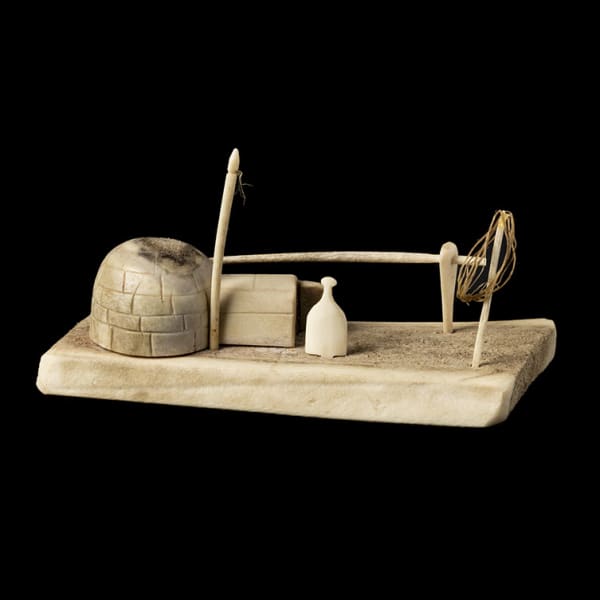On the heels of the record breaking success with a very big Barnabus Muskox , I am reminded of the made up unit of measurement that is used to describe the carvings that fill most every available surface in my tiny Toronto apartment. In order to find a spot in my home, I promise myself that a work must be “hand-sized” so as to not impinge on my already crowded living quarters.
The term is adequately self-descriptive. “Hand-sized” carvings are masterful little works that manage to compress tremendous sculptural and visual value into just a few inches.
Since they are streamlined to fit in one’s palm, it becomes easy to envision the way that the artist would steady the stone in one hand as he or she carved with the other. Likewise, the very act of being able to grasp a small scale work encourages its viewer to consider it from several angles as we turn it over in our hands. To hold and examine these “hand-sized” works is to intimately appreciate their charm and their very three-dimensionality.
I can think of no more succinct description of the charm of small sculptures than by the respected Globe and Mail, Art and Artist columnist Pearl McCarthy. In her October 1957 review of a show at the Canadian Handicraft Guild, McCarthy wrote, “All pieces should be judged not by a style but by how hard it is for the visitor to obey the request: ‘Please do not handle’” [1].
We encourage your visit and to inquire with us about holding and examining these “hand-sized” works for yourself.
In our continued effort to support the Government of Ontario’s physical distancing guidelines and to ensure safety of our staff and community, we are now accepting appointments to view the works in this exhibition any time between Monday and Friday 10:00 AM - 4:00 PM. Previews will be held at A.H. Wilkens Auctions & Appraisals, One William Morgan Drive, East York, ON.
If you are unable to attend our previews in person, our team can provide thorough and comprehensive condition reports and additional images and videos. We welcome your enquiries at info@firstarts.ca or 647-286-5012.
— Nadine Di Monte
1. Pearl McCarthy, “Eskimo Carvings Developing”, The Globe and Mail (Toronto), 29 Oct 1957, p. 13.
-
Works
-
-

MATTIUSI IYAITUK (1950-) IVUJIVIK
Torso, 1996stone, 4.625 x 2.75 x 2.25 in (11.7 x 7 x 5.7 cm)
titled, signed, and dated, "TORSO / ᒪᑎᐅᓯ / 96".
Mattusi Iyaituk's artistic exploration of the human body in the present Torso, 1996 recalls the creative epiphany of the finest 19th sculptors, including Auguste Rodin. Though it is curio-cabinet appropriate in its size, the softly arched back and active stance — albeit with truncated limbs reminiscent of the marbles of Greek and Roman antiquities — of the present work convey a powerful sense of movement.SOLD
-
JAMASIE PITSEOLAK
Like his grandfather, Peter Pitseolak — Baffin Island's first indigenous photographer — Jamasie's works remind us that not all Inuit art fits within the confines of preconceived notions of what Indigenous art should look like. Beginning in the late 90s, Jamasie endeavoured to intersect decidedly modern imagery from everyday life — such as cars, sewing machines, and other equipment and machinery — with traditional materials and techniques. Working in a style akin to assemblage sculpture, regardless of size, Jamasie carves with a variety materials, using contrasting pieces of different coloured stone, antler, or other inlaid materials to create whimsical, fascinating figures and objects.
-
-
-

ROBERT KUPTANA (1962-) PAULATUK / OTTAWA
Mosquitostone, horn, and baleen, 3.25 x 3.5 x 3 in (8.3 x 8.9 x 7.6 cm)
unsigned.
As with Lilting Butterfly (featured later in this exhibition), in the present work, Robert Kuptana offers us a whimsical winged creature, whose assemblage is significantly more complexly composed. The mosquito is a very visible feature of Arctic life in the summer but they also play an important role in traditional Inuit stories. Versions of how the mosquito came to be includes a parable of the dangers of being a slovenly wife [1]. Others connect the story to giants or cannibalism and starvation [2][3]. Though they are considered a pest, mosquitoes, according to Barnabus Arnasungaaq, could be a good omen. The arrival of the bloodsucking bugs indicated that the caribou were coming [4].
1. Lucien M. Turner, Ethnology of the Ungava District, Hudson Bay Territory. 11th Annual Report of the Bureau of American Ethnology for the Years 1889-1890, John Murdoch, ed. 159-350. (Washington, D. C. Smithsonian: 1984[1979]), p. 100
2. Frédéric Laugrand and Jarich Oosten, “Qupirruit: Insects and Worms in Inuit Traditions," Arctic Anthropology, 2010, Vol. 47, No. 1, 2010), p. 12
3. Knud Rasmussen, Intellectual Culture of the Iglulik Eskimos. Report of the Fifth Thule Expedition 1921-24., vol. VII. (Kobenhavn: Gyldendalske Boghan del, Nordisk Forlag, 1929), p. 271); Rasmussen, Iglulik and Caribou Eskimo Texts. Report of the Fifth Thule Expedition 1921-24, vol. VII (Kobenhavn: Gyldendalske Boghandel, Nordisk Forlag, 1930), p.21-22
4. Hattie Mannik, Inuit Nunamiut: Inland Inuit (Altona: Friesen Corporation, 1998), p. 217
$150.00
-
-

ABRAHAM ETUNGAT, R.C.A. (1911-1999) KINNGAIT (CAPE DORSET)
Bird with Upswept Wingsstone 3 x 1.75 x 1 in (7.6 x 4.4 x 2.5 cm)
signed, "ᐃᑐᒐ".
The motif of a bird with upswept wings was a frequent subject for sculptor Abraham Etungat. Usually
titled ‘Bird of Spring’, each rendition has its own individual personality. One was made into a bronze
cast, which stands seven feet in height on public display in Vancouver, Calgary, Toronto and Halifax. In
terms of size, this miniature sculpture is the opposite. The artist has pushed the stone to its limits, as can be seen in the breathtaking translucence of the wings and beak which enliven the beautiful green stone and appears as if glowing. It is truly a small gem.$1,200.00
-
John Kavik
Born in Uqsuqtuuq (Gjoa Haven) in 1897, John Kavik moved via Qamani'tuaq to Kangiqliniq where he began to carve in the 1960s. The rough-hewn forms of these two works are characteristic of Kavik's approach to his preferred motif: the human figure, which he primarily explored through a language of radically reduced abstraction.
TUNA IQULIQ
Born in Baker Lake, Tuna (Toona) Iquliq began his carving career in Rankin Inlet in the 1960s before returning to Qamani'tuaq in 1969. The influence of the Rankin sculptors, particularly Kavik, are visible in these two works in their "primal," semi-abstract forms. Birds became a mainstay subject for the artist and he continued to carve their likeness steadily until his death in 2015.
-
-
-
-

LUCAS ATTAGUTSIAK (1958-), IKPIARJUK (ARCTIC BAY) / OTTAWA
Lilting Butterfly, December 2010antler, 6 x 3.5 x 4.5 in. (15.2 x 8.9 x 11.4 cm)
signed with initials and dated, "LA / 12. 2010."
The present Lilting Butterfly is a delightful example of the subject matter from which Attagutsiak rarely strays. In a September 2010 article in the Ottawa Citizen, author Kelly Egan explained that Attagutsiak is a carver "but not a typical one. He only carves one thing: butterflies, but does so exquisitely." Attagutsiak responded, "'I've tried to carve other things but I don't know [...]."' The unadorned white antler coaxes the viewer to take stock of the shapes and lines of the insect and emphasize implied motion and form. Exquisite indeed.
SOLD
-
-
-
-
-

EVA TALOOKI ALIKTILUK (1927-1995) ARVIAT (ESKIMO POINT)
Seated Mother Holding Childstone, string, floss, beads, 3.25 x 1.5 x 2.5 in (8.3 x 3.8 x 6.3 cm)
unsigned.SOLD.
-
-

JOHN PANGNARK (1920-1980) ARVIAT (ESKIMO POINT)
Figure, c. 1970-73stone, 2.75 x 3.5 x 1 in (7 x 8.9 x 2.5 cm)
signed, "ᐸᓇ".Born in 1920 at Windy Lake some 300 miles west of Arviat, Pangnark came to maturity in the semi-nomadic, traditional Inuit way of life, before settling in Arviat in the 1950s. He began to carve in the 1960s and quickly became celebrated for the distinctive, minimalist style in his representations of the solitary human figure — a theme that he approached with boundless variation. With its streamlined form and broad planes restricted to essential features only, Figure from the early 1970s — at just 3.5 inches at its largest dimension— has the simplicity and purity redolent of some of the finest large scale works by the artist.SOLD
-
-

UNIDENTIFIED ARTIST, GREENLAND
Tupilak, c. 1972horn and antler inlay, 4.5 x 1 x 1.25 in (11.4 x 2.5 x 3.2 cm)
unsigned.
In the late 1960s the Royal Greenland Trade Department imported a quantity of buffalo horn from Africa with which tupilak carvers were encouraged to experiment. For the next several years, the project yielded brilliant results, including the present work.
Provenance
Ex. Coll. Lorne Balshine, Vancouver;
With Walker's Auctions, Ottawa;
A Montreal Collection.SOLD
-
-
The Ex. Collection of Mr. Douglas Banks
These lovely sculptures were originally acquired in the Arctic by Douglas Banks who was the president of the Belcher Mining Corporation. Banks made numerous trips to the region in the early to mid 1950's. These works were part of an exhibition at the Marion Scott Gallery in Vancouver (June 11 - July 20, 2005) entitled The Banks Collection: Early Sculpture from Sanikiluaq . The exhibition shed light on the wonderful work being done at an important time in the development of contemporary Inuit art. -
-
-
-
The Norman Hallendy Collection
This selection of small carvings – mostly ivory but incorporating other materials as well – are from the collection of ethnogeographer Norman Hallendy, collected mostly during a short period from 1968 to 1971.
During his time in Cape Dorset, Hallendy received the name Apirsuqti, meaning "The Inquisitive One" because, according to Mr. Hallendy, he was always asking questions so that he "could learn about nature, animals, and people, and how they lived." Hallendy continued to serve as a civil servant to Canada and helped to form much of the public policy aimed at improving the lives of those living in Canada's arctic. His published ethnographic documentations of the Inuit remain a major contribution to the study and appreciation of Inuit culture.
In 2018, in recognition of his ethnography of the Inuit in the Canadian Arctic, the Governor General of Canada, Julie Payette, awarded Hallendy the Polar Medal created by Her Majesty the Queen of England.
In November 2019, First Arts mounted an exhibition of the miniatures and other small works from Mr. Hallendy's collection. To view this exhibition, please visit this link.
-

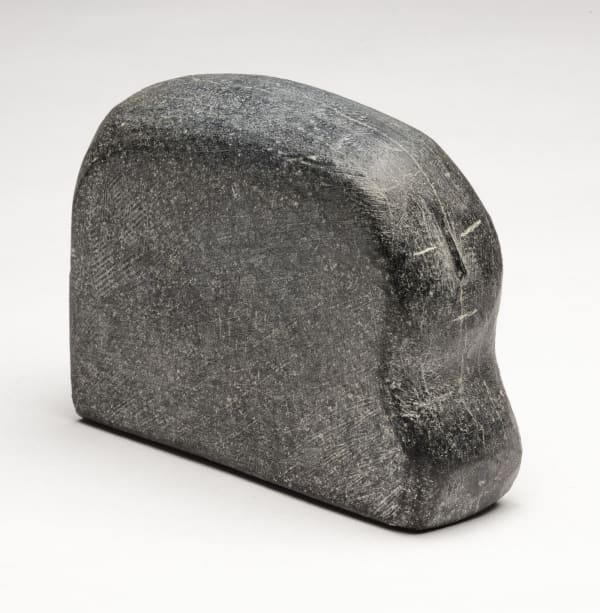
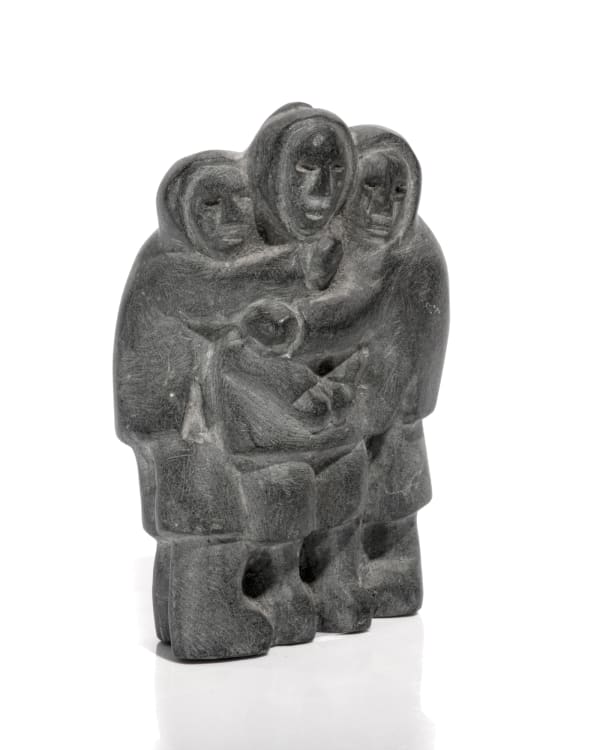
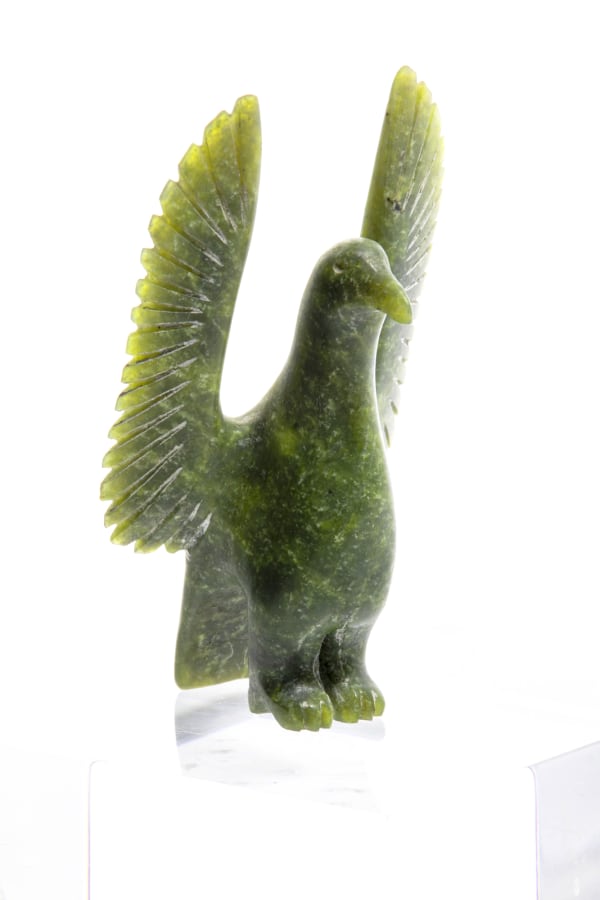

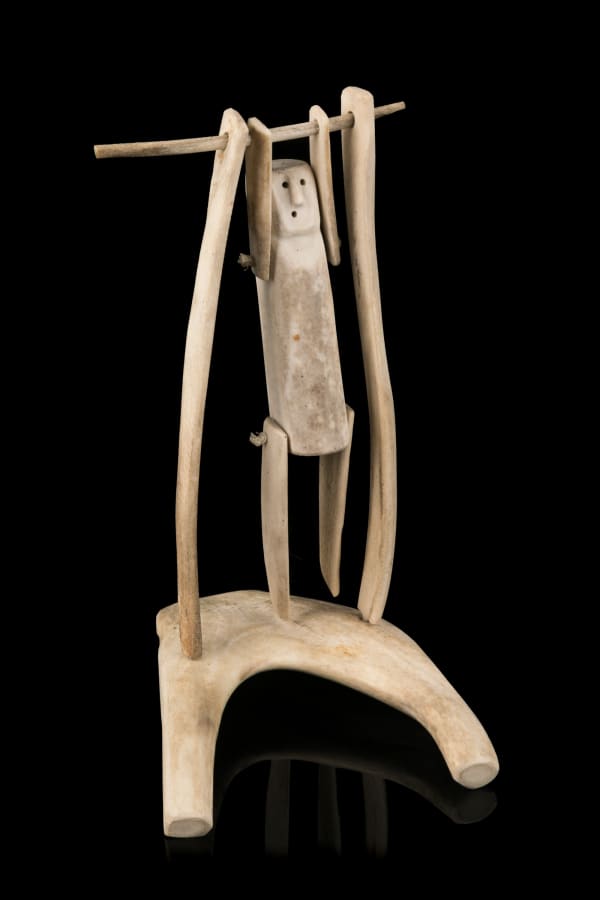
![CECILIA ANGMADLOK ANGUTIALUK (1938-) NAUJAAT (REPULSE BAY) Bust of a Woman, c. 1970-75 stone, 4.5 x 2.25 x 4.5 in (11.4 x 5.7 x 11.4 cm) signed, "ᐊᒪᓗ"; inscribed, "ᓇᐅᔭ" (Naujaat [Repulse Bay]).](https://artlogic-res.cloudinary.com/w_600,c_limit,f_auto,fl_lossy,q_auto/artlogicstorage/firstarts/images/view/1ff5a8c3a1fdfc87343fd2c139b2181aj/firstarts-cecilia-angmadlok-angutialuk-1938-naujaat-repulse-bay-bust-of-a-woman.jpg)























![SILAS KAYAKJUAK (QAYAQJUAQ) (1956-) SANIRAJAK (HALL BEACH) Spirit Head bone, 2.5 x 1 x .75 in (6.3 x 2.5 x 1.9 cm) signed indistinctly in syllabics, "ᓯᐊᓕᓴ [?]"; signed, "SILAS".](https://artlogic-res.cloudinary.com/w_600,c_limit,f_auto,fl_lossy,q_auto/artlogicstorage/firstarts/images/view/de1ec400a2d53dfaead16139abb4a71ej/firstarts-silas-kayakjuak-qayaqjuaq-1956-sanirajak-hall-beach-spirit-head.jpg)




































